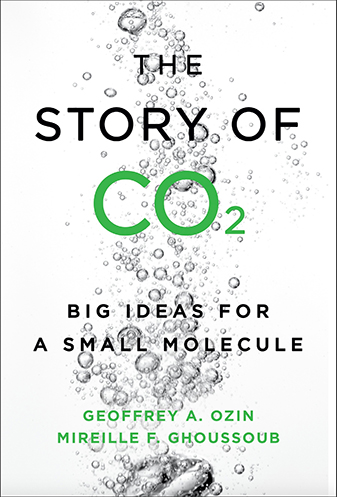According to Geoffrey Ozin, the spark that inspired the book, The Story of CO2: Big Ideas for a Small Molecule, came when his six-year-old grandson interviewed him for a school project about inventors.
Ozin, a professor in the Faculty of Arts & Science’s Department of Chemistry, says his grandson understood that carbon dioxide, CO2, was “a bad molecule that scientists say is causing our planet to get hotter and hotter.”
“So, I took him to my lab and showed him how we collect CO2 from the air,” Ozin said during the online launch of the book in November. “And I showed him how we can convert it into useful things like fuels and other chemicals just by adding a pinch of sunlight and some hydrogen.”
His grandson’s response? “That's a fantastic invention, gramps. Why aren't we doing it?”
The question helped Ozin realize the time was right for telling the story of CO2.

Published by University of Toronto Press, The Story of CO2 is in part a natural history of the small molecule from the creation of the universe in the Big Bang 13.8 billion years ago to today.
It is also part manifesto or call-to-action to reduce levels of the gas in our atmosphere by doing more than reducing emissions or converting to renewable energy sources as we have been doing.
Ozin and his co-author, Mireille Ghoussoub, make the case that CO2 levels can also be reduced by looking at the gas as a resource that can be transformed into products such as plastics, pharmaceuticals and polymers, the chemicals used in manufacturing. It can also be used, they point out, as a fuel that can reduce our dependence on fossil fuels.
Ozin is a University Professor — U of T’s highest faculty distinction — and a Canada Research Chair in Materials Chemistry. His research is in the fields of inorganic, physical, as well as polymer and material chemistry. He is also the founder of U of T’s Solar Fuels Cluster, where he spearheads an interdisciplinary group working toward a zero-emission CO2 economy.
Ghoussoub has her PhD in materials chemistry from the Department of Chemistry and researches CO2 reactions on the surfaces of nanoscale catalysts using computational and spectroscopic techniques. She is also a member of the Solar Fuels group.
“I’m a millennial,” says Ghoussoub about her motivation for co-authoring the book. “And I feel I’ve been hearing about pollution reduction and climate change forever.
“When I was 11, I tried to make biodegradable cups out of mud and glue — and failed. Later, I watched An Inconvenient Truth and felt deeply concerned about global warming.”
In The Story of CO2, Ozin and Ghoussoub present innovative ways of using the CO2 we produce as a resource.
For example, many hydrocarbon products such as gasoline, formaldehyde, acetic acid and propylene — currently derived from fossil fuels — can instead be made from methanol which in turn can be made from CO2 emissions and renewably sourced hydrogen.
“Methanol is an amazing chemical,” says Ghoussoub. “If we can find a way to make methanol sustainably from CO2, we can make some 60 per cent of all the chemicals in the world from it.
“Methanol can also be used as a fuel itself. That would create emissions but the whole point is to keep fossil fuels in the ground and to try to use waste carbon wherever possible to eventually create a carbon-neutral economy.”

According to Ozin, “The production of cement is another major contributor to CO2 emissions. And the amount of cement being used in the world — it's absolutely incredible.”
As the authors describe in the book, the production of cement is the leading source of CO2 from construction materials, with the four billion tons produced each year accounting for 8 per cent of global emissions.
The cement manufacturing process involves heating calcium carbonate — limestone — to 1,000 C. Not only does this require the burning of fossil fuels, it produces huge amounts of CO2 because the production of every 1,000 kilograms of cement results in 900 kilograms of CO2.
“So, we need to eliminate the use of fossil fuels in this process,” says Ozin. “And we need to collect the CO2 and put it back into the cement which makes for a lighter, stronger product.”
According to Ozin, the good news is that companies are already doing this.
CarbonCure has developed a method for incorporating recycled CO2 into concrete — a process with the potential to eliminate hundreds of millions of tons of CO2 emissions annually.
In addition, Air Company captures CO2 and transforms it into ethyl alcohol which they then use to produce spirits such as vodka, as well as fragrances, sanitizers and other consumer products.
And Pond Technologies supplies “bioreactors” and “growing systems” that capture greenhouse gases and produce algae which can then be used as a food source for animals and as a raw material in the manufacture of hydrocarbon-based products such as biofuels or cosmetics.
The strides being taken by these companies is news that would please Ozin’s grandson and according to Ghoussoub, “There's new science emerging every day. It's a really exciting time to be in this field.”
“It was very important to get out the story,” says Ozin, “that CO2 is more than a molecule creating the greenhouse gas problem.
“We're all in it together,” he says of the threat of the climate crisis. “And we all have to work together in order to take care of this problem.”

